|
Report from
Europe
UK tropical wood trade succumbs to
pandemic impact
The value of UK imports of tropical wood products was
US$360 million in the first four months of 2020, 19% less
than the same period last year. Although a significant
decline, the downturn is perhaps less than might have been
expected given the exceptional circumstances surrounding
COVID-19.
It is also notable that the start of the decline for most
products predated the period of lockdown initiated in the
UK from 24th March. UK wood furniture imports from
tropical countries have been weakening since the start of
2019 and were particularly slow in February this year.
Imports of tropical plywood and sawnwood have also been
sliding since the middle of 2019 (Chart 1).
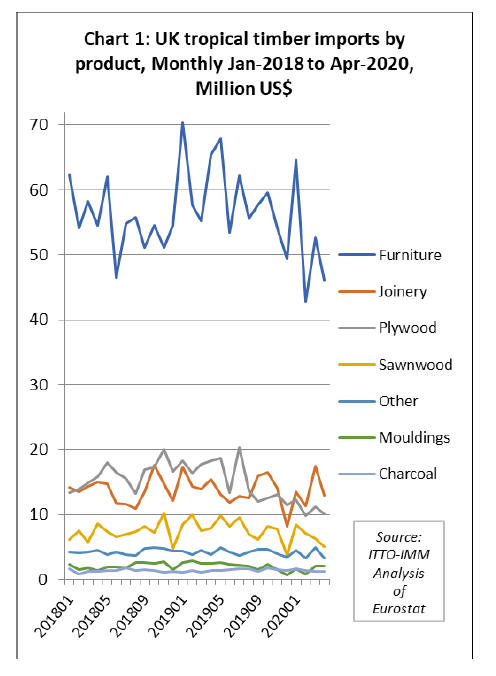
The trade data to end April implies that the market was
slowing even before the lockdown was implemented and
has probably captured only a small portion of the COVID-
19 downturn. A more severe downturn can be expected in
May and June.
To some extent weak imports in February and March this
year were due to the earlier implementation of COVID-19
lockdown measures in Asian countries which disrupted
raw material supplies and exports, particularly of wood
furniture from South East Asia and tropical hardwood
faced plywood from China.
Comparing the first four months of 2020 with the same
period the previous year, UK import value of wood
furniture from tropical countries fell 17% to US$206.1
million.
Imports of tropical plywood were down 39% at US$43.4
million, tropical joinery products were down 9% at
US$55.2 million, tropical sawnwood fell 20% to US$26.9
million, and mouldings/decking declined 35% to US$6.8
million (Chart 2).
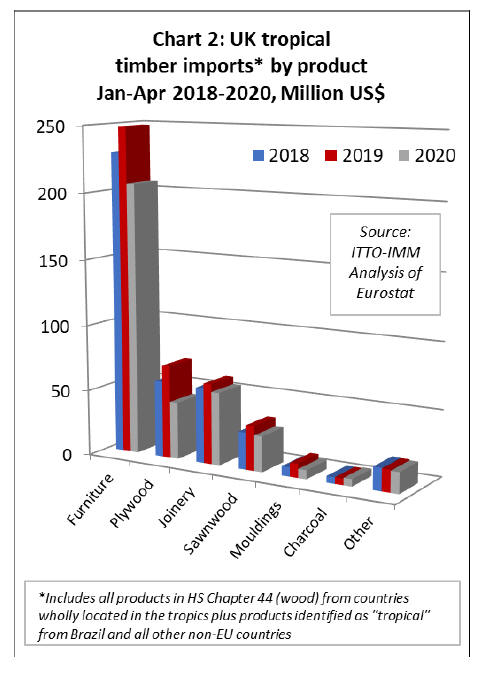
UK imports of wood furniture declined sharply from all
the leading tropical supply countries in the first four
months of this year (Chart 3).
Imports from Vietnam were down 17% at US$109.5
million, imports from Malaysia fell 18% to US$43.2
million, imports from Indonesia declined 23% to 18.4
million, and imports from India fell 17% to US$15.4
million.
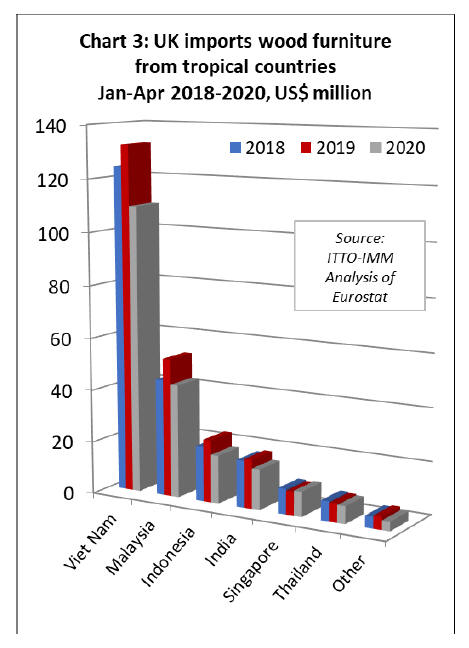
Indonesia loses ground in UK joinery market
After making gains in 2019, UK imports of tropical
joinery products from Indonesia, mainly consisting of
doors, fell 16% to US$31.5 million in the first four months
of this year.
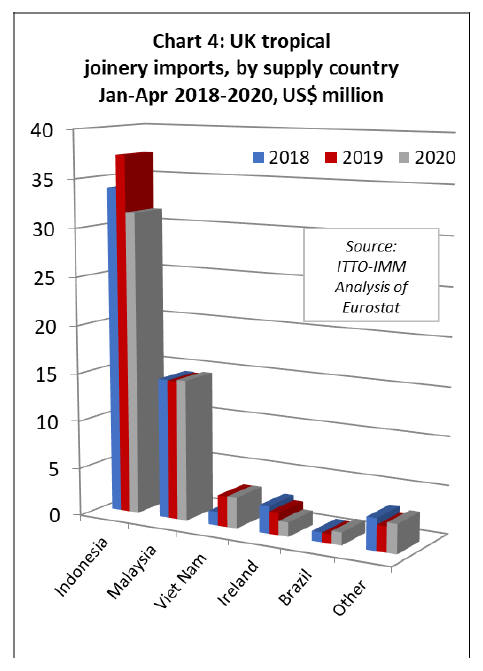
In contrast, UK imports of joinery products from Malaysia
and Vietnam (mainly laminated products for kitchen and
window applications) made slight gains in the first four
months of this year, increasing by 1.3% to US$14.7
million from Malaysia and by 0.8% to US$3.2 million
from Vietnam. (Chart 4 above)
UK imports of tropical hardwood plywood from China
crash
The UK imported 26,600 cu.m of tropical hardwood faced
plywood from China in the first four months of this year,
66% less than the same period last year. UK imports were
at unusually high levels in the first half of 2019 after a
period of slow buying in 2018 due to Brexit uncertainty.
However, the market suffered from over-stocking in the
second half of last year as consumption slowed. This year,
UK imports have been further dampened by COVID
related supply problems in China.
Likely due to supply problems elsewhere, UK imports of
plywood from Malaysia, which have been in long term
decline, recovered ground in the first four months of 2020,
rising 55% to 24,200 cu.m.
However, imports from Indonesia fell 27% to 15,000
cu.m. In recent years, the UK has been importing small
volumes of tropical hardwood faced plywood from Latvia.
Imports of this commodity were up 21% at 3,600 cu.m in
the first 4 months of 2020. (Chart 5)
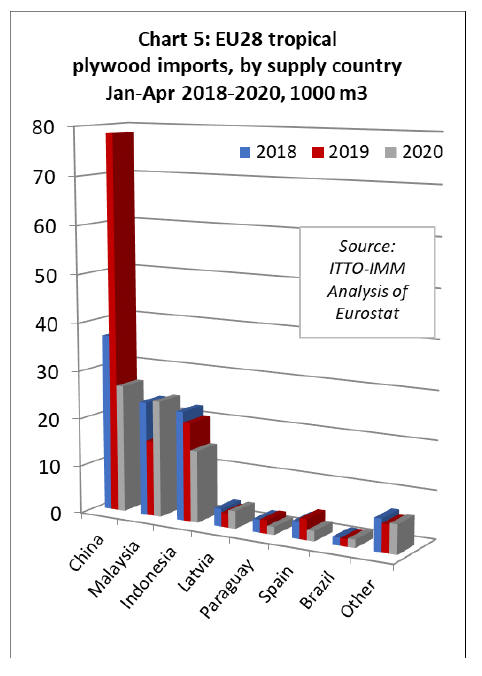
UK tropical sawn hardwood imports small but diverse
The UK is now a relatively minor market for tropical sawn
hardwood, importing less than 100,000 cu.m in each of the
last two years, making it only the fifth largest European
importer for this commodity (after Belgium, Netherlands,
France and Italy).
UK imports of 30,000 cu.m in the first four months of
2020 were 12% less than the same period in 2019.
UK tropical sawn imports are sourced from a large range
of countries, both directly in the tropics and indirectly
from other European countries (Chart 6).
UK imports from Cameroon, the leading supplier,
increased 5% to 7,700 cu.m during the four-month period,
while imports from the Republic of Congo were also up,
by 4% at 5,100 cu.m. However, imports from DRC fell to
negligible levels in the first four months of 2020 after
reaching more than 2,200 cu.m in the same period last
year.
UK imports from Malaysia were 5,400 cu.m in the first
four months of 2020, 4% less than the same period in
2019. Indirect imports into the UK via the Netherlands
were down 6%, at 3,200 cu.m, after significant growth last
year. Imports from Brazil increased 14% to 1,800 cu.m,
while imports from Guyana were up nearly 60% at 1,300
cu.m.
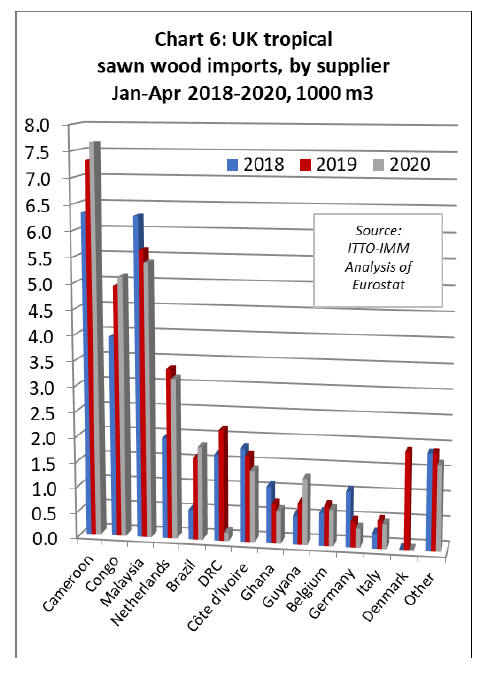
Many UK merchants lack space and finance to carry the
ideal inventory of tropical sawn hardwood which should
include a wide range of boards in different widths and
lengths for bespoke joinery work. Most UK merchants
therefore focus on stocking just the more familiar types of
hardwood, in defined ranges to suit particular market
segments.
The main tropical hardwood species in demand in the UK
now are sapele, meranti, utile and for decking, Bangkirai.
Sapele is strongly favoured as a good all-rounder for both
internal and external joinery with reasonable density and
good machining capabilities and good for paint
applications.
Utile is still favoured as it tends to be more stable than
many external hardwoods. Idigbo/framire (mainly from
Cote d¡¯Ivoire, was formerly popular but importers report
having difficulty obtaining assurances required for EUTR
compliance.
Meranti is still popular in UK window and door
manufacturing, although wide variation in the density of
meranti supplied has been an increasing issue for some
importers and manufacturers. Many merchants also stock
meranti mouldings for the replacement market, including
skirtings, architraves and window cill sections.
Challenges, but some cautious optimism in UK
Further insights into the status of the UK sawn hardwood
market came from a webinar organised by the London
Hardwood Club in early June, featuring speakers from the
UK tropical import sector alongside American and
European hardwood producers.
The event, which attracted 48 participants, covered
pandemic impacts, species supply and demand trends, UK
market acceptance of further processed hardwood products
and market outlook.
Despite the COVID 19 lockdown measures, in place now
in the UK for nearly two months, there are some more
positive signs emerging in the UK hardwood market.
Several seminar participants said that the market remained
¡®some way off the norm¡¯, but that business was picking
up.
¡°At the start of the Covid-19 lockdown we were looking at
the sharp end of doing very little at this point and in April
sales were down 60-65%,¡± said one importer.
¡°But through May into June we¡¯ve seen renewed activity
and we¡¯re now back to around 60% of normal levels.¡±
Another said they had gradually upped activity: ¡°We
closed for two or three weeks, but now we¡¯ve got 50% of
staff working. We don¡¯t see sales returning to 100% in the
near future, but we hope to have all our people back by the
end of the government furlough programme in October.¡±
Focusing on West African supply, Guy Goodwin of NHG
said that, bar a temporary shutdown in Ghana, the
pandemic had not to date significantly hit production.
Prices for red hardwoods also remained firm, underpinned
by renewed buying in China and Vietnam.
Mr Goodwin anticipated mills ¡®in the tiers below
mainstream producers¡¯ being most affected by wider
contraction in demand, leading to some price cutting.
Cancelled orders had also seen some ¡®distressed parcels¡¯
coming on to the market.
However, he did not anticipate the tropical price slump
and capacity contraction seen after the 2008 economic
crash. ¡°Mills learned the lesson from that and became
more cautious and reactive to the market situation, so
there¡¯s less over-production,¡± he said.
¡°Also, many concession holders are at the end of 25-30-
year harvest cycles, so forest being worked is less rich in
commercial species. We expect this to keep prices firm,
particularly for kiln-dried, certified, EUTR-compliant
timber.¡±
For the European hardwood supply sector, Alex Boisson
of Italian-based oak producer Florian Group, said the
pandemic had reduced demand internationally and the
outlook was uncertain.
The Asian market was particularly hard hit and overall the
post-pandemic so-called ¡®new norm¡¯ had yet to take shape.
¡°Business is moving, but not as we knew it,¡± he said.
¡°Requests are day to day.¡±
Florian had faced mill operational challenges due to
COVID-19, but its key concern was the three month
shutdown in harvesting in Croatia and Hungary, where it
also has mills in addition to those in Italy and France.
Resulting tight supply was underpinning log prices, which,
Mr. Boisson forecast, would lead to lumber price inflation,
despite demand levels.
He also said that it was imperative to develop the market
for the ¡®central part of the log¡¯. Hardwood sawmills need
to sell lumber from the entire thickness and grade
spectrum of the log, both to turn a profit and avoid
finished stock build up and associated bottlenecks and
overheads.
Demand for lower grade European lumber had been hit by
the pandemic, notably in South East Asia and this
compounded the effect of deterioration in European raw
material quality.
¡°In the last 10- 15 years European logs have declined in
quality and diameter,¡± said Mr. Boisson. ¡°Previously the
resource was yielding 30% A quality logs. Today that¡¯s
down to 15-20%. We increasingly need to be creative and
find an outlet for lower grades, perhaps through
modification, or engineering and new applications. It¡¯s key
to how we survive as sawmills.¡±
On the UK, Mr. Boisson said there was more hardwood
stock on the ground than elsewhere in Europe, the
consequence of ¡®excess buying¡¯ prior to lockdown, with
importers hedging against anticipated logistical problems.
The market, he added, was also historically more resistant
than European neighbours to value-added, further
processed products. By contrast, German window
producers, for instance, tended to use fingerjointed and
laminated hardwood exclusively.
This sentiment was echoed by a UK timber importer who
noted that ¡°UK end users are conservative. They¡¯re wary
of anything new and not particularly fashion-led.¡±
However, there were signs of UK end users coming
around.
Mr Boisson commented that ¡°five years ago, our
engineered exports to the UK were zero. Today they
comprise 25% of the total. We expect the trend to continue
and that we¡¯ll be selling less solid, thick lumber to the
market.¡±
Speaker Dennis Mann, export sales manager of Baillie
Lumber, a leading US hardwood exporter, emphasised that
the poor prospects for lower grades was also a major issue
facing the American hardwood industry. ¡°Our key
challenge is what to do with the centre of the log. Right
now, there¡¯s just no home for sleepers, cants, truck deck
flooring, pallet timber, or chips for paper mills,¡± said Mr
Mann.
¡°A lot of these products are tied in with transportation of
goods and as that¡¯s significantly reduced, so has demand.¡±
Mr. Mann suggested that as economies emerge from
pandemic lockdown more widely, this industrial lumber
logjam should gradually ease, but the timescale was
uncertain and, while unresolved, it could cause further
problems.
Difficulties in moving lower quality material inevitably
impact supply of better grades and Mr Mann predicted
tightening supply in 1.5-2¡± and thicker white oak in
coming months.
Turning to the UK, Mr. Mann said it had not only
remained the U.S. hardwood sector¡¯s biggest European
market, and fourth biggest export market overall, it was
also among its most consistent. Its annual U.S. imports
averaged around $83 million for the last four years,
comprising 75-80% white oak, tulipwood and walnut.
One question from a webinar participant was on future
supply of American ash given the emerald ash borer
infestation. Mr Mann responded that there were still areas
of pest-free forest, particularly away from roads. ¡°Ten
years ago we thought it would all be gone by now,¡± he
said.
¡°Today we estimate there¡¯s still another three to five years
supply of viable, unaffected timber.¡±
Mr. Mann was also asked about U.S. supply of FSCcertified
and said demand for it was mainly from the UK.
¡°FSC requests are 90- 95% UK, with inquiries monthly.
From elsewhere we¡¯ll get two or three every few months.¡±
One importer saw increasing prospects for modified
temperate hardwoods to widen applications for less
durable material. ¡°We¡¯ve done a number of successful
projects in thermally modified U.S. tulipwood, with
another significant one in the pipeline,¡± they said. ¡°We
think it¡¯s got a good future.¡±
UK still in lockdown while rest of Europe eases
restrictions
Lockdown measures in the UK, one of the nations most
affected by COVID-19, are being eased but more slowly
than elsewhere in Europe. Strict social distancing is still in
place, with restrictions on the numbers of people that can
meet from separate households. People who can work
from home should continue to do so "for the foreseeable
future".
UK workplaces may only open if made safe for staff, with
more cleaning, staggered working shifts and, for office
workers, no hot-desking. Most people entering the UK -
including British citizens ¨C must self-isolate for 14 days.
UK citizens are strongly advised not to travel abroad.
Most schools are still closed.
In continental Europe, lockdown measures are being lifted
cautiously, in phases. Businesses are reopening and many
children are back in school. Many of Europe's internal
borders will be open again from mid-June and there are
hopes that external borders will be lifted from 1 July.
Germany began reopening shops in April. In early May
control of lifting the lockdown was handed to the 16
federal states. But Chancellor Angela Merkel stressed that
an ''emergency brake'' will be applied anywhere that sees a
surge in new infections.
Italian lockdown restrictions were eased from early May
and people are now able to travel for longer distances, as
well as visit their relatives in small numbers. On 3 June,
Italy unilaterally reopened its borders and ended regional
travel restrictions.
In France, restrictions began to ease on 11 May, and phase
two of the easing began on 2 June, including an end to a
100km (62-mile) travel limit. Nearly all of France is now
in a so-called "green zone", where restrictions can ease
faster. Paris has moved from a red to an orange zone.
Belgium, the world's worst affected country in terms of the
number of deaths per head of population, entered a third
phase of deconfinement measures on 8 June, with the
reopening of hotels, bars and restaurants, extended social
life and eased tourism restrictions.
The Netherlands imposed a far less strict lockdown than
neighbouring countries. Prime Minister Mark Rutte
unveiled a five-phase plan for easing lockdown
restrictions, which kicked in from 11 May and is now well
advanced.
On 1 June, Spain moved into a second phase of the
planned removal of lockdown for 70% of Spaniards.
However, Madrid, Barcelona and some other regions
continue under tighter phase-one restrictions. The state of
emergency is to end on 21 June, restoring freedom of
movement.
Portugal, which has had fewer coronavirus cases and
deaths than some other south European nations, is now
near the end of a three-phase plan announced on 4 May to
reopen different sectors of the economy every 15 days.
Greece, another country so far less affected by the
pandemic, has been relaxing lockdown measures since
28th April and has declared that the tourist season will
start on 15 June, with the opening of seasonal hotels on the
same day.
Poland is due to open borders with other EU countries on
13 June, lifting restrictions, mandatory quarantine, and
border controls for EU nationals who will be free to travel
and transit through the country. Fitness clubs, cinemas,
theatres, and amusement parks, which have remained
closed for two months, were allowed to open from 6 June.
OECD predicts UK to suffer largest economic
downturn
The UK is forecast to suffer the worst recession of the
world¡¯s 37 rich nation economies as GDP shrinks by up to
14 per cent this year and one in ten workers are left
unemployed. In its latest global forecasts, the Organisation
for Economic Cooperation and Development (OECD)
ranks the UK alongside France, Italy and Spain, saying
that all four countries will lose more than a tenth of
national output to the pandemic in 2020.
The OECD modelled two scenarios. The first assumes that
the virus recedes and the second models a second spike in
the final three months of the year.
A second spike is judged by the OECD to be just as likely
as the virus remaining under control.
In the benign scenario, the UK suffers the deepest
recession of all OECD members, just ahead of France, as
the economy shrinks by 11.5% in 2020 and unemployment
jumps to 9.1% from 3.9% at the last official reading.
In the double hit scenario, Spain and France fare slightly
worse as UK GDP falls 14% and unemployment climbs to
10.4%. Germany and the US shrink by just short of 9% in
the worst case scenario. All countries recover some of the
lost ground in 2021, with catch-up growth under both
scenarios.
Sharp decline in European construction continues in
May
Although the headline figures from IHS Markit
Construction Purchasing Managers Index (PMI) for the
eurozone and UK in May were better than in April, they
still indicated a steep decline in construction activity. For
the eurozone, the PMI rose to 39.5 in May, up from a
record low of 15.1 in April (a score below 50 indicates
contraction).
Survey data showed Germany and France recorded a third
straight month of decreasing construction output in May,
although the decline slowed markedly amid easing
lockdown measures. Italy posted a marginal rise in
construction activity in May following a collapse in April.
Business expectations among eurozone building
companies remained negative in May, with the Future
Activity Index coming in below the neutral 50.0 level for a
third straight month.
Concerns were linked to the longer-term impact of the
COVID-19 pandemic on construction activity. Germany
and France both reported a negative outlook, while Italian
business sentiment turned positive for the first time in
three months.
The UK construction sector also suffered one of its worst
results in May since the PMI surveys began as building
work was grounded by the pandemic and lockdown
measures. Construction firms fear a recession and
postponement of new projects in the next year despite a
gradual reopening of sites in May.
The IHS Markit/CIPS UK Construction PMI registered at
28.9 in May, picking up from the record low of 8.2 in
April. Around 64% of the UK survey panel reported a
drop in construction activity during May, while only 21%
signaled an expansion. Growth was attributed to a limited
return to work on-site following shutdowns in April due to
the coronavirus outbreak.
As in the eurozone, UK building companies remained
downbeat about their prospects for the next 12 months.
Recession worries and fears of postponements to new
projects were commonly reported.
Throughout the eurozone and in the UK, construction
supply chains remained under severe pressure in May,
with delivery times continuing to lengthen at the secondquickest
rate in the PMI series history.
Anecdotal reasons suggested logistical bottlenecks,
material shortages at distributors and limited supplier
capacity due to social distancing rules.
|